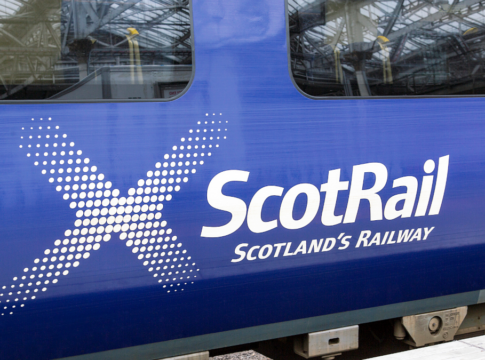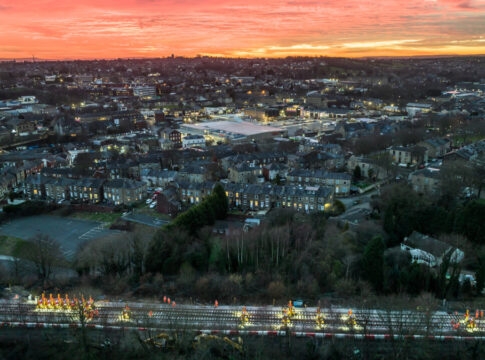Trains powered by electricity rather than diesel fuel are not scheduled to begin rolling on the Fairmount Line for years, but public officials are so excited about the now-concrete plans for more frequent service with less pollution that they gathered in the hot sun Tuesday morning to celebrate an achievement that likely won’t be attained until 2028.
The MBTA voted July 25 to approve a $54 million contract with Keolis, the company that operates commuter rail for the MBTA, to bring battery electric service to the Fairmount Line that runs from South Station through Dorchester, Mattapan and Hyde Park.
“I just can’t wait ’til it’s done,” Marilyn Forman, a co-chair of the Fairmount Indigo Transit Coalition who works on housing production at the Codman Square Neighborhood Development Corporation, said at a press conference at Morton Street Station in Mattapan on Tuesday. “But we still have so much more to do, and maybe, just maybe, because we work with some amazing people, it will happen before 2028.”
Gov. Maura Healey, who has myriad priorities hung up in the Legislature, promised the state’s approach to the project would be “pedal to the metal on all of this.” The idea has been “talked about for years,” the governor said, “but we’re doing it, we’re finally doing it.”
The nine-station Fairmount Line runs through areas that suffer from higher rates of air pollution, and ridership on it has more than doubled compared to pre-pandemic counts, according to Keolis. The line’s popularity, its relatively short length and its proximity to electric infrastructure helped make it a good fit for battery-electric service, Keolis said.
“We chose to submit an innovation proposal because we have the skills and we have the knowledge to deliver this project quickly and efficiently,” John Killeen, vice president of asset management at Keolis, said. “Keolis will manage this project including the procurement of financing, the choosing of the rolling stock, and the upgrade of engineering facilities, infrastructure and maintenance facilities. We will bring our international skills and expertise to ensure that this project is a success.”
Fairmount Line trains currently run on 30-minute intervals, MBTA General Manager Phil Eng said, and plans call for arrivals on a 20-minute frequency once the line is electrified. He said transportation accounts for 38 percent of greenhouse gas emissions in Massachusetts and the T accounts for 1 percent of those emissions. The project, he said, will cut fuel use by 1.6 million gallons per year.
Areas along the T’s Providence Line have electrification potential, Eng said, and electrification is being examined in an environmental justice corridor on the Newburyport-Rockport line.
“This is just the beginning. This is a peek into the future, but we’re bringing it within our lifetimes,” Eng said. He added, “Technology is getting better, so we know that this technology works in other parts of the world. The key is how do we make it work here for us.”
While Fairmount is poised to become the first commuter rail line in Massachusetts to become fully electrified, Boston Mayor Michelle Wu said the project would electrify “one of the last remaining diesel commuter rail lines in the country.”
“It’s not just about saying the words to be a green community,” Wu said. “This is about tangible benefits that our residents who live here, that workers who are getting to their jobs, that visitors and tourists and everyone we welcome in our community will be able to feel every single day.”
Sen. Liz Miranda said she was encouraged by the promise of more frequent service on the “Purple Line,” as she said it’s called in areas it serves. She said every state resident deserves access to safe, reliable transit and recalled years earlier in her life when she didn’t want to ride on the Fairmount Line because it was “scary, it took too long, it was dirty.”
“Growing up, I’d rather take two buses and a train, at the speed that the Fairmount Line, the Purple Line, used to take and now we don’t have to wait for two buses and a train anymore,” Miranda said. “We can actually take the commuter rail, and the Fairmount Line, all the way to downtown, not only waiting only 20 minutes but to make sure that it gets to downtown quicker, so that we can get to work or get to school.”
Rep. Brandy Fluker Oakley credited Sen. Nick Collins and former legislators Linda Dorcena Forry and Jack Hart as well as community members for creating three new stations on the line in 2013 and one more in 2019and “saying ‘no, y’all need to stop and pick us up.’”
“Without a history, the people perish,” Fluker Oakley said. “You all have to understand that this train ran through our Black community regularly and did not stop to pick us up. I need you to think about that — a diesel train running through a predominately Black and brown community, not even having the intentionality to pick us up to let us go to work.”
The state calls battery-electric multiple unit trains BEMUs and says they use hybrid power with an onboard battery that charges when overhead catenary wires are available, such as at South Station. The trains can then run on battery power, emitting less air pollution and reducing energy consumption and providing passengers with smoother rides, more space, and quieter service, according to the state.
The MBTA has been stung over the years by contractors who have not delivered new trains on time.
“We’re really mindful of what we enter into when we sign these contracts,” Healey told reporters after Tuesday’s press conference, when asked about the anticipated electric trains. “I’m demanding, I want accountability from anybody, you know, it’s taxpayer money. I demand that in in our contracts. I demand that, that accountability. You can’t play with us if you can’t perform. It’s as simple as that. And you know, I’m confident in the deals that we have now, and we’re going to continue to stay on this as a team to see this through.”
Source: GBH




You wonder what the litres saved might be if V/Line actually did the right thing and electrified to Waurn Ponds and Wendouree with the amount of fuel those Vlocity Trains use. Could be a short payback with the price of diesel high and going up further. Also the great positive impact on the environment.